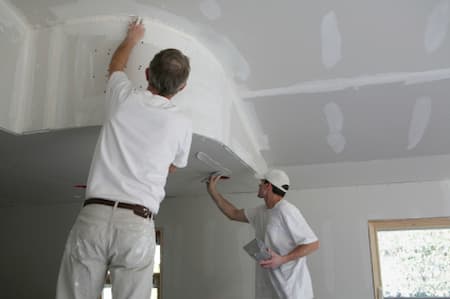Effective Drywall Repair Techniques to Restore Your Walls
Effective Drywall Repair Techniques to Restore Your Walls
Blog Article
Drywall Installment Facilitated: Tips for Perfect Outcomes
Drywall installment is typically viewed as an overwhelming job, yet with the best technique and knowledge, it can end up being a workable undertaking. Mastering techniques for cutting, hanging, and ending up drywall can considerably impact the result.
Choosing the Right Materials
Choosing the appropriate materials for drywall setup is important to attaining a durable and aesthetically pleasing coating. sheetrock repair fort worth. The primary part, drywall sheets, commonly can be found in different densities, with 1/2-inch sheets being standard for interior wall surfaces. For areas needing additional moisture resistance, such as shower rooms or cooking areas, consider using environment-friendly board or concrete board, which are particularly developed to withstand humidity

Furthermore, selecting the appropriate bolts-- either screws or nails-- is vital for safeguarding the drywall to the framing. Drywall screws are typically favored for their holding power and minimized risk of standing out. Finally, think about the finishing touches such as guide and paint, which not only boost the look but additionally safeguard the drywall from moisture and wear.
Preparing the Installment Area
Before beginning the drywall installation procedure, it is vital to prepare the installment location thoroughly. This preparation involves several critical actions to make certain a smooth and effective task. First, clear the area of any furnishings, home appliances, or blockages that can prevent access. A clean workspace decreases the danger of damage to existing items and permits reliable movement during installation.
Next, inspect the wall surfaces and ceiling for any kind of flaws, such as fractures, openings, or mold. Address these problems in advance; spot any kind of damages and enable enough time for repair work to dry. In addition, ensure that electric outlets, buttons, and pipes are effectively placed and accounted for, as this will certainly affect drywall positioning.
Think about the environmental problems also. A secure temperature and moisture degree are important for ideal bond and performance of the drywall materials. If needed, make use of a dehumidifier or heating unit to create appropriate problems.
Trimming and Hanging Drywall
The trick to reliable drywall installment hinges on the precise cutting and dangling of the panels. Begin by determining the space accurately, considering any type of blockages such as electrical outlets or home windows. Utilize a straight edge and an utility blade to rack up the drywall along your measurements, then break it along the racked up line for a clean break. For more complex cuts, such as around outlets, a drywall saw can be made use of for precision.

Constantly work from the top down and left to right, making sure that you maintain a staggered pattern to enhance security. Appropriately hanging the drywall establishes the structure for a smooth surface, ultimately causing premium lead to your drywall job.
Insulation and Mudding Strategies
While proper cutting and dangling of drywall sets the stage, the following essential step includes mastering taping and mudding methods to guarantee a smooth surface. Insulation is crucial for reinforcing joints and stopping fractures; it includes embedding tape right into the applied joint substance This Site (mud) Beginning with a quality fiberglass or paper tape, using the tape over the joint and pushing it into the wet mud utilizing a taping blade, making sure no air bubbles continue to be.
As soon as the tape is in place, apply a slim layer of joint substance over the tape, feathering the edges to create a smooth transition to the drywall surface area. Allow this layer to dry entirely prior to sanding it gently to get rid of flaws. Repeat this procedure, applying extra layers of mud as needed-- typically 2 to 3 layers-- while slowly expanding the application area with each layer to achieve a seamless look.
After the final layer dries, sand the surface with a fine-grit sandpaper till smooth. drywall repair. Bear in mind to wear a mask article throughout sanding to stay clear of inhaling dust bits. Mastering these taping and mudding techniques is vital for achieving a professional-quality coating in your drywall setup
Ending Up Touches for Perfection
Attaining a perfect drywall installment surpasses taping and mudding; it finishes in the ending up touches that boost the overall look. These last steps are essential in ensuring a professional-grade finish that boosts the visual appeals of your room.
Begin by fining sand the dried joint substance to produce a smooth surface. drywall contractor. After sanding, clean down the wall surfaces with a moist towel to get rid of any type of dust fragments, making sure a tidy surface area for painting.
Next, use a guide especially made for drywall. This action is vital, as it assists secure the joint substance and offers a consistent base for the topcoat. When the guide dries, inspect for any type of imperfections, and repair as needed.
Final Thought
In verdict, successful drywall setup hinges on the mindful selection of materials, comprehensive preparation of the setup area, and exact implementation of cutting and hanging methods. Mastery of taping and mudding processes is vital for attaining a smooth coating.
Drywall setup is frequently perceived as a difficult task, yet with the appropriate approach and knowledge, it can become a convenient endeavor.Picking the ideal materials for drywall installation is vital to attaining a sturdy and aesthetically pleasing surface.Before starting the drywall installation process, it is vital to prepare the installment area thoroughly. Mastering these taping and mudding techniques is crucial for achieving a professional-quality coating in your drywall setup.
In verdict, successful drywall installation hinges on the mindful option of materials, thorough prep work of the installment area, and accurate implementation of reducing and hanging methods.
Report this page